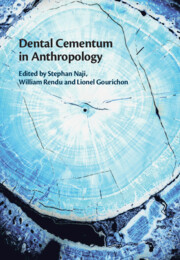Book contents
- Dental Cementum in Anthropology
- Dental Cementum in Anthropology
- Copyright page
- Dedication
- Contents
- Contributors
- Foreword
- Introduction: Cementochronology in Chronobiology
- Part I The Biology of Cementum
- 1 A Brief History of Cemental Annuli Research, with Emphasis upon Anthropological Applications
- 2 Development and Structure of Cementum
- 3 Insights into Cementogenesis from Human Disease and Genetically Engineered Mouse Models
- 4 A Comparative Genetic Analysis of Acellular Cementum
- 5 Pattern of Human Cementum Deposition with a Special Emphasis on Hypercementosis
- 6 Recent Advances on Acellular Cementum Increments Composition Using Synchrotron X-Radiation
- 7 Incremental Elemental Distribution in Chimpanzee Cellular Cementum: Insights from Synchrotron X-Ray Fluorescence and Implications for Life-History Inferences
- 8 Identifying Life-History Events in Dental Cementum: A Literature Review
- Part II Protocols
- Part III Applications
- Index
- Plate Section (PDF Only)
- References
7 - Incremental Elemental Distribution in Chimpanzee Cellular Cementum: Insights from Synchrotron X-Ray Fluorescence and Implications for Life-History Inferences
from Part I - The Biology of Cementum
Published online by Cambridge University Press: 20 January 2022
- Dental Cementum in Anthropology
- Dental Cementum in Anthropology
- Copyright page
- Dedication
- Contents
- Contributors
- Foreword
- Introduction: Cementochronology in Chronobiology
- Part I The Biology of Cementum
- 1 A Brief History of Cemental Annuli Research, with Emphasis upon Anthropological Applications
- 2 Development and Structure of Cementum
- 3 Insights into Cementogenesis from Human Disease and Genetically Engineered Mouse Models
- 4 A Comparative Genetic Analysis of Acellular Cementum
- 5 Pattern of Human Cementum Deposition with a Special Emphasis on Hypercementosis
- 6 Recent Advances on Acellular Cementum Increments Composition Using Synchrotron X-Radiation
- 7 Incremental Elemental Distribution in Chimpanzee Cellular Cementum: Insights from Synchrotron X-Ray Fluorescence and Implications for Life-History Inferences
- 8 Identifying Life-History Events in Dental Cementum: A Literature Review
- Part II Protocols
- Part III Applications
- Index
- Plate Section (PDF Only)
- References
Summary
Dental hard tissues contain periodic incremental markings that can be used as an absolute temporal archive to reconstruct their growth and can incorporate trace elements into their chemical structure during formation that reflect diet, the environment, metabolism, and health. The growth history can be recovered from teeth using virtual tooth histology to resolve a continuous record of trace element composition within each of the mineralized dental tissues, to further our understanding of past life history events in extant and extinct taxa. While acellular cementum forms slowly and regularly and is ideal for recording annual increments, compensatory cellular cementum can mirror this regular growth through gradual physiological changes in anterior tooth inclination. Here, we document this growth through microstructural elemental mapping using non-destructive synchrotron x-ray fluorescence on chimpanzee dental thin sections. We evidence clear seasonal mineral fluctuations, and match the narrower, brighter incremental markings visible in TLM with peaks in mineral concentration in zinc and strontium.
- Type
- Chapter
- Information
- Dental Cementum in Anthropology , pp. 138 - 154Publisher: Cambridge University PressPrint publication year: 2022



